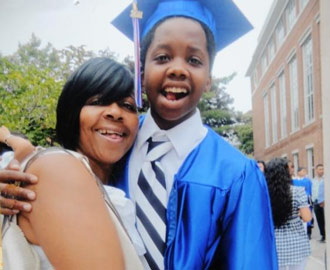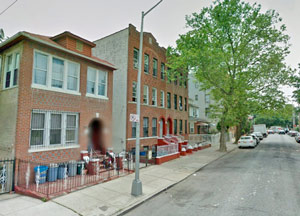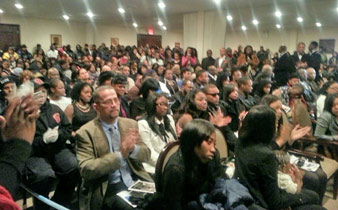By Saeed Shabazz-Staff Writer-

NEW YORK (FinalCall.com) – “They stole my son’s potential,” Carol Gray said the day after her son, 16 year old Kimani Gray was laid to rest.
The Brooklyn teenager killed March 9 by two plainclothes officers, members of the Street Crime Unit, after allegedly pointing a .38 caliber revolver in their direction, was heading to a party with friends when the encounter occurred on a quiet street in a predominately Caribbean American, working-class neighborhood.
“This is a quiet neighborhood of hard working people,” 44 year old Darryl, told The Final Call about his neighborhood. He heard the fatal shots that night, which surprised him. “In my two years on this block, I don’t remember hearing any shots, this is not a block with a lot of teenage traffic,” the fire safety director said.
According to published reports by the Medical Examiner’s Office, the teen was shot seven times, three bullets hitting him in the back.

“I had to hold her (Carol Gray) tightly in my arms during the wake–telling her it would be alright,” anti-police brutality activist Juanita Young told The Final Call. “Nobody can tell you about that pain–the life that came out of you–torn away by bullets fired by cops. Holding her I felt the hole in my heart; left by the police killing of my son Malcolm.”
Her son, Malcolm Ferguson, died in a Bronx apartment building stairwell after an undercover officer shot him point blank–first claiming the 23 year old had a gun but later saying the young man tried to get his gun. The Bronx District Attorney refused to indict the officer. A Bronx jury in a civil case, not believing the officer’s version of the incident, awarded Ms. Young $10 million as a settlement.
“I am tired of writing these stories, going to these funerals–seeing the pain in the faces of these mothers–while they cry out, ‘why did they kill my child!’ ” Naya Arinde, editor of the Black weekly Amsterdam News told The Final Call. She interviewed the victim’s mother.
No one believes Kimani had a gun, Ms. Arinde added.
“The problem is, we can’t give the benefit of the doubt to the police, because of the constant harassment of Black and Latino youth in this community,” a young man who would only give his first name, Moses. The 23 year old spoke to The Final Call after finishing a basketball game in the Tilden Playground, two blocks from the scene of the shooting in East Flatbush.
“I have been stopped by the cops at least five times since I turned 18,” said the young college graduate, who majored in communications.
Young people are not going to give a free pass to the police after these types of incidents, said Student Minister Abdul Hafeez Muhammad of the Nation of Islam’s Mosque No. 7 in Harlem. He spoke at Kimani’s wake, telling youth “there can only be healing, if they are willing to listen to good guidance.”

He told the overflow crowd the key was unity and not allowing others to lead them in the wrong direction.
Over 50 people have been arrested since the shooting, as activists vowed to protest for 67 days. The neighborhood where the shooting happened is patrolled by the 67th Precinct. Protestors want the two officers involved prosecuted and charges dropped against demonstrators who expressed outrage over the shooting. “The people are fed up,” said Brooklyn Councilman Charles Barron.
“Seeing Ms. Gray sobbing uncontrollably, brought back painful memories,” Nicholas Heyward, Sr. told The Final Call. His son, Nicholas Naquan Heyward, Jr. died at the hands of an NYPD officer back in 1994, while playing in the stairwell of his Brooklyn Housing Project building. He was playing cowboys and Indians with a friend and both had toy guns.
Eighteen years later nothing has changed, Mr. Heyward said. He recited a list of those killed by NYPD officers: Shantel Davis, Timur Person, Patrick Dorismond, Noel Polanco, Tamar Robinson, Ramarley Graham, Reynaldo Cuevas, Sean Bell.
“There have been 226 people killed by police (in New Jersey and New York) since the killing of Amadou Diallo,” Mr. Heyward noted.
Amadou Diallo, a 23 year old Muslim immigrant from Guinea, was killed in a hail of 41-bullets from the guns of four undercover NYPD officers in the vestibule of his Bronx apartment building in 1999. The officers claimed they thought his wallet was a gun. A jury found all four officers innocent.

The two officers named in the killing of Kimani Gray, Sgt. Mourad Mourad and Patrolman Jovaniel Cordova, were reportedly placed on administrative duty. News reports indicate both had been sued for alleged violations of civil rights of Black New Yorkers with illegal stop and searches and false arrest, costing taxpayers over $200,000 in settlement payouts.
“They should not have been on the street, particularly in a ‘Street Crime Unit.’ It shows disrespect for the Black and Latino community,” Damon K. Jones, New York representative for 100 Blacks in Law Enforcement told The Final Call.
In an e-mail, Mr. Jones noted that the NYC Comptroller’s Office last year said the city paid out $185.6 million in claims against NYPD officers in 2011, a 35 percent increase over what was paid out in 2010. The comptroller’s report revealed 8,882 claims were filed in 2011 against officers–a 55 percent rise in claims over the past five years.
Anti-police misconduct activist De Lacy Davis, a retired sergeant from the East Orange, N.J. police department and president of Black Cops Against Police Brutality told The Final Call placing those officers back on the street “shows a wanton disregard for what the impact is when you put officers with problematic histories back into Black and Latino communities.”
The killing of Kimani Gray must be seen as “a questionable shooting until all of the facts are in,” he said.
Councilman Jumaane Williams, a Democrat whose 45th Council District encompasses the neighborhood where the shooting took place, calls it “law and order without accountability.”
The mayor and police commissioner do not want to acknowledge a need to discuss rethinking public safety in New York City, he told The Final Call. “The youth see more police coming into the neighborhood but not the resources they need,” the first-term councilman said.
“We have to play basketball outside on a cold day like this. The nearest indoor recreation center is over three miles from here,” A.J., 16, and a classmate of Kimani Gray, said while taking 30-foot jumpers during a game of Horse in the Tilden Playground. A.J. and the other teens refused to admit to a gang problem in their neighborhood, instead they all agreed being harassed by police was their “biggest problem.”
Victor Rivera, 45, lives two-doors down from where Kimani Gray fell after being shot. She agreed that a community center is “sorely” needed.
“What is also needed is for the police to change their perception of this community–everyone here works hard–this is not a bad neighborhood,” he added.
“The night of the shooting there were no noise complaints, that is why we question the real motive for the police stopping the teens,” Mr. Rivera told The Final Call.
Pastor Gideon Akers, associate pastor at the Premier Baptist Church at the corner of Utica and Tilden Avenues, told The Final Call that the church wasn’t waiting for the city to bring resources to the area. “Beginning in April, we will initiate our encounter group program, and the first step will be an open house forum where people will be able to tell us what they believe is needed in the community,” Pastor Akers said.
This neighborhood is made up of a diverse Caribbean community where people have a lot of problems adjusting to life in America, he said. “Yes, there is a gang problem but they respect the church,” Pastor Akers said.












